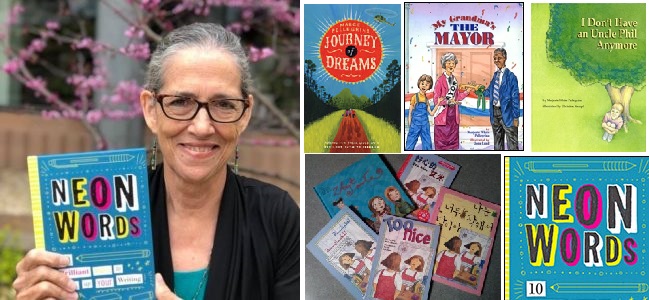Interview by Tiziano Thomas Dossena
Marge Pellegrino is a successful author who also taught writing skills to students for over thirty years. She has won many awards and published quite a few books, earning a good response from readers, reviewers and educators alike. Her short story White Mountain is part of A Feast Of Narrative: an Anthology of Short Stories by Italian American Writers, which will be published this month by Idea Press. Here follows a wonderful interview with our magazine.
L’Idea Magazine: Marge, you wrote six books and I’d like to talk about them. Two of them in particular, although addressed in quite a different matter, share a common topic, the plight of Guatemalan refugees. Could you tell us more about these two novels?
 Marge Pellegrino: The Sculpture Speaks: A Refugee’s Story of Survival, co-written with Marianna Neil, shares the story of the woman depicted in the John Houser sculpture on display in Tucson, Arizona’s Southside Presbyterian Church. The bronze piece depicts a refugee woman holding her forearm protectively over the baby she cradles against her body. Touched by the story of her flight and displacement, as well as the courage of those who helped her, I committed to work with refugee survivors of torture in a program called Owl & Panther. The book grew over the years. Published in 2019, profits of sales go to Owl & Panther, where Marianna also worked, both of us for decades. Our retelling in narrative poetry inspired poignant mono-prints by Aida Algosaibi-Stoklos as well as a play by Monica Bauer, which was slated for a staged reading in Phoenix in March just as the pandemic hit.
Marge Pellegrino: The Sculpture Speaks: A Refugee’s Story of Survival, co-written with Marianna Neil, shares the story of the woman depicted in the John Houser sculpture on display in Tucson, Arizona’s Southside Presbyterian Church. The bronze piece depicts a refugee woman holding her forearm protectively over the baby she cradles against her body. Touched by the story of her flight and displacement, as well as the courage of those who helped her, I committed to work with refugee survivors of torture in a program called Owl & Panther. The book grew over the years. Published in 2019, profits of sales go to Owl & Panther, where Marianna also worked, both of us for decades. Our retelling in narrative poetry inspired poignant mono-prints by Aida Algosaibi-Stoklos as well as a play by Monica Bauer, which was slated for a staged reading in Phoenix in March just as the pandemic hit.
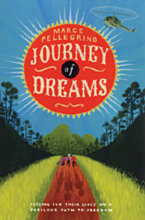 Journey of Dreams, a novel for middle school students, grew from my need to better understand the Owl & Panther families. The expressive arts activities I facilitated lay bare a longing my students felt for their homeland as illustrated by Walter Hernandez’s list poem: I miss my home/ I miss my country/I miss the mountains/ I miss my flag/ I miss what I was. That longing represented a mystery I needed to solve. Why did these families long for a place where they had been treated so cruelly? Would a story of a girl and her family’s flight help kids born here better understand why a refugee might sit next to them at school? And if they did gain a better understanding, might they be kinder? Journey of Dreams earned awards and a starred review. Although it’s now out-of-print, teachers and librarians still contact me to help locate copies. So, I am looking for a new publishing home so it can continue to validate, inform, and possibly change hearts.
Journey of Dreams, a novel for middle school students, grew from my need to better understand the Owl & Panther families. The expressive arts activities I facilitated lay bare a longing my students felt for their homeland as illustrated by Walter Hernandez’s list poem: I miss my home/ I miss my country/I miss the mountains/ I miss my flag/ I miss what I was. That longing represented a mystery I needed to solve. Why did these families long for a place where they had been treated so cruelly? Would a story of a girl and her family’s flight help kids born here better understand why a refugee might sit next to them at school? And if they did gain a better understanding, might they be kinder? Journey of Dreams earned awards and a starred review. Although it’s now out-of-print, teachers and librarians still contact me to help locate copies. So, I am looking for a new publishing home so it can continue to validate, inform, and possibly change hearts.
L’Idea Magazine: Three of your books, “Too Nice,” “My Grandma’s the Mayor” and “I Don’t Have an Uncle Phil Anymore” are published by the American Psychological Association’s Magination Press. What do they have in common besides the publisher?
 Marge Pellegrino: I write to increase understanding to empower for both the reader and myself. Nearly always, the themes of my stories touch on community and how an individual might impact or be impacted by people and surroundings. For example, My Grandma’s the Mayor shares the story of Annie who is miffed by the interference her grandmother’s job provokes. When a fire breaks out nearby, she finally understands her grandmother’s drive to serve. Annie transforms that understanding into action and learns just how good it can feel to help others.
Marge Pellegrino: I write to increase understanding to empower for both the reader and myself. Nearly always, the themes of my stories touch on community and how an individual might impact or be impacted by people and surroundings. For example, My Grandma’s the Mayor shares the story of Annie who is miffed by the interference her grandmother’s job provokes. When a fire breaks out nearby, she finally understands her grandmother’s drive to serve. Annie transforms that understanding into action and learns just how good it can feel to help others.
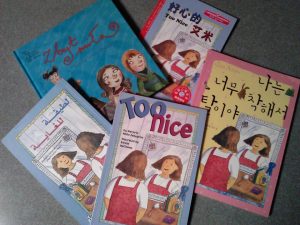 Too Nice can now be read in five different languages. It’s the story of Amy, who struggles with her tendency to be way too nice. A mistake she makes leads to a discussion with her grandfather while they work together in the garden. Through her “aha” moment, Amy learns and practices how she can set personal boundaries. The result? She is kinder to herself as well as her friends.
Too Nice can now be read in five different languages. It’s the story of Amy, who struggles with her tendency to be way too nice. A mistake she makes leads to a discussion with her grandfather while they work together in the garden. Through her “aha” moment, Amy learns and practices how she can set personal boundaries. The result? She is kinder to herself as well as her friends.
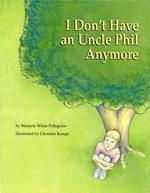 I Don’t Have an Uncle Phil Anymore grew directly from a moment after the death of my thirty-seven-year-old brother. I was devastated. One day, my young son ignored me when I called him in for lunch. He ignored me a second time, then a third. When he finally came inside, he let me know that I had interrupted him. He had been playing ball with Uncle Phil. He threw the ball up into heaven and my brother threw it back. What a gift! The story, which shifted my grieving, started in my journal, later appeared in a parenting magazine, and then became my first picture book. A celebration of a child’s inner wisdom, Uncle Phil has been used in classrooms to invite conversations about the ways we learn, and how we might celebrate one of our own wisdom moments.
I Don’t Have an Uncle Phil Anymore grew directly from a moment after the death of my thirty-seven-year-old brother. I was devastated. One day, my young son ignored me when I called him in for lunch. He ignored me a second time, then a third. When he finally came inside, he let me know that I had interrupted him. He had been playing ball with Uncle Phil. He threw the ball up into heaven and my brother threw it back. What a gift! The story, which shifted my grieving, started in my journal, later appeared in a parenting magazine, and then became my first picture book. A celebration of a child’s inner wisdom, Uncle Phil has been used in classrooms to invite conversations about the ways we learn, and how we might celebrate one of our own wisdom moments.
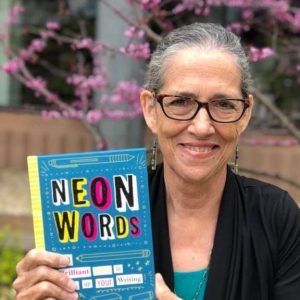 L’Idea Magazine: Neon Words: 10 Ways to Brighten Your Writing is your other book that we have not mentioned, yet. What is that book about?
L’Idea Magazine: Neon Words: 10 Ways to Brighten Your Writing is your other book that we have not mentioned, yet. What is that book about?
Marge Pellegrino: Written with artist and writer Kay Sather, Neon Words is my legacy. It tells what I learned in thirty years of nurturing student writers. Whether the writing is personal, or intended for sharing, those interested in expressing themselves will find useful direction. Neon Words offers ten tools to support a writing practice, ten prompts to explore on the page, and ten fun art activities that honor the words. The book was written with teenage writers in mind, but it’s been embraced by educators, counselors, and adults who want to write solo or in a community.
L’Idea Magazine: You also wrote more than 150 nonfiction articles for 28 periodicals. What do you usually write about in these articles?
Marge Pellegrino: My nonfiction usually explores something I want to know more about, something that matters, like medical advancements, or something that makes readers’ lives better, brighter, or more fun. My most recent piece was published in “Anthropology Now,” co-written with Maisa Taha, a professor at Montclair State University in New Jersey, about community collaboration. I have written news stories for a rural community’s newspaper, and book, art, and field trip reviews. I’ve written how-to and bio pieces, and covered refugees, nonprofits, and justice. For a year when my son was young, I had a parenting column, which provided the perfect cover to research challenges my husband and I experienced as parents.
A cover story for the Tucson Guide featured the DeGrazia Gallery of the Sun. Ted DeGrazia, best know for his UNICEF card of children dancing in a circle, fascinated me, in part because of his Italian roots. He was born of immigrant parents. When the mine his father worked for closed in Arizona, his parents immigrated back to Italy, where DeGrazia spent some of his formative years. Another mine lured the family back to Arizona, where Ted had to relearn English, and where as an adult, he flourished as an artist. He painted, sculpted, and even built his own adobe galleries with the help of his Yaqui and Tohono O’odham friends. When I began my research, I was warned that his ghost sometimes appeared in the library on the grounds. Apparently I posed no threat. I worked uninterrupted for several days, pouring over the archives of this creative character.
L’Idea Magazine: You won many awards. Which of them do you hold dearest to your heart and why?
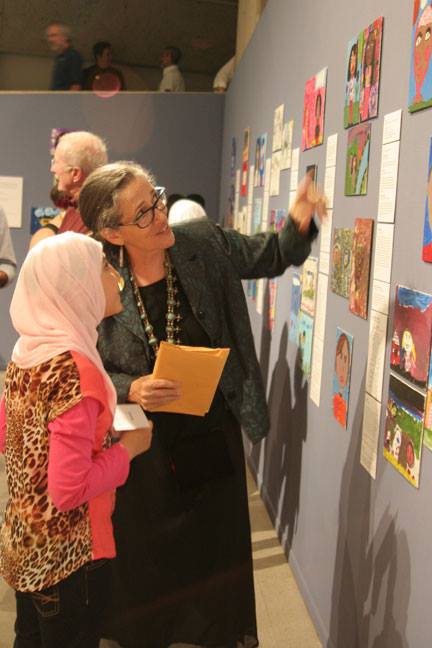
Marge Pellegrino: The national “Coming Up Taller Award” for excellence in after-school programming was awarded to Word Journeys, a program I designed and facilitated through the Pima County Public Library for twelve years. The program trained teen mentors to interact with elementary students in dynamic literacy activities at the library. What a joy it was to watch the teen, who accompanied me to Washington, DC to attend the ceremony, experience her first flight, interact with students from around the country, see iconic American landmarks, and accept the award from then First Lady, Laura Bush!
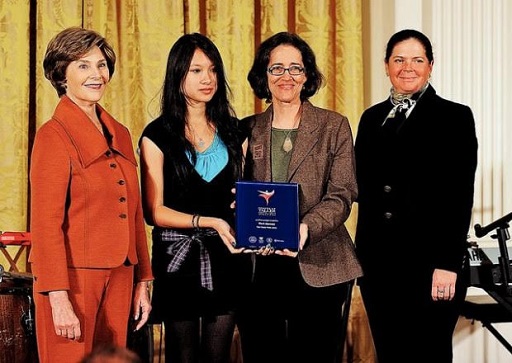
L’Idea Magazine: As a speaker, you touch many topics. Could you tell us about some of them?
Marge Pellegrino: In addition to my books, I’ve been invited to speak about writing, refugees, literacy programming, and building community!
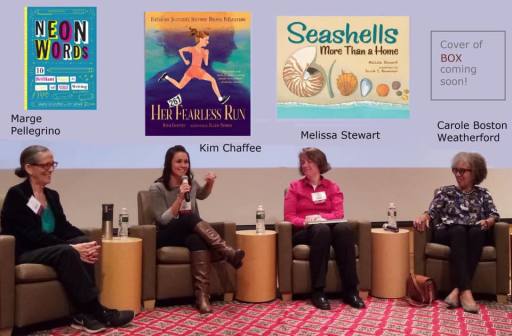
L’Idea Magazine: Along with being an award-winning writer, you are a workshop facilitator. What exactly do you do in that function? Could you give us some examples of your work?
Marge Pellegrino: My workshops are interactive, and as such, each is enriched by the people who come to play.
At the Tucson Museum of Art, I’ve facilitated “Writing from Image” for a variety of audiences, including regular museumgoers, refugee families, and a military grief support group. The writing activities invite the participants to interact with art. We each select a piece of art and describe our choice. While describing art through writing can be fun and a respite, the close attention required will permanently connect us to that work of art; we’ll remember it always. We try out different voices and write as though we are talking to the art. Then we write what the art might say. We choose words from our writing, or borrow some from the museum’s descriptions of the art and move those words around for a surreal found-poem. We end with a collaborative poem—where each of us reads our contributed line aloud. Each line begins: “Today at the museum….” These activities strengthen individuals’ thinking skills and confidence, and model how to jump into meaningful conversations within our own families to build understanding and cohesiveness.
“Building a Better Community” is a workshop I’ve facilitated for libraries, neighborhood associations, and even a Chamber of Commerce. We brainstorm the strengths of the community. We consider what might make the community stronger. After sharing and riffing off these ideas, we each identify and commit to take one action that would either support one of the existing strengths, or further one of the new ideas.
A favorite workshop described in Neon Words is “Trash to Treasure.” We write down the metaphorical trash in our lives, like conflicts or challenges, on colored scrap paper and rip up the list. Then we blend the stamp-sized pieces with water. The resulting pulp is used to create a beautiful handmade-paper cover for the small book we construct. The book has both visible pages and private ones only the author knows are there. On the visible pages, we capture the “Strategies to Transform Trash into Treasure” that we’ve brainstormed, such as observing, listening, asking questions. On the private pages, we write about a moment when we successfully overcame an obstacle. Tied up with a ribbon, this finished project is a gift to ourselves, to open the next time we’re challenged—a reminder of strategies that could help, as well as a previous personal triumph that helps us remember that we have what it takes to overcome.
L’Idea Magazine: You are also very involved in your community…
Marge Pellegrino: In addition to the community organizations we support through memberships and donations, I’m a long-time member of the Friends of the Pima County Public Library, the Tucson Audubon Society, and our neighborhood association. I provide editing work for Rescue Me—Animal Adoption as well as mentor other writers and small nonprofits. I’m looking forward to facilitating virtual school workshops for Community Share, and continue outreach for Owl & Panther, recently serving on a panel for the new crew of AmericaCorp members who will be doing their civic service in Southern Arizona. And while listening to podcasts, I’ve been sewing discarded socks together to create a quilt for Kino Border Initiatives.

L’Idea Magazine: Do you have any projects you are working on at the moment?
Marge Pellegrino: In addition to a novel revision and several picture book projects, I’ve been working on a social media page for the Tuckahoe History Committee. The page was started as a vehicle for my dad to continue engaging with his passion during the pandemic.
Tuckahoe was once celebrated as the marble capital of the world. Italian immigrants worked the four quarries that punctuated this mile-square village in Westchester, New York, that lies sixteen miles north of Grand Central Terminal. The Washington Square Park’s Arch, St. Patrick’s Cathedral, the Marble Palace in lower Manhattan, the Brooklyn and New Orleans City Halls, and the Marble House in Providence, Rhode Island, all of these structures, and more, were constructed with Tuckahoe’s strong, sparkled snow-white marble. My dad spent most of his life volunteering and serving in elected offices in Tuckahoe, where he was born. He knew the history intimately because he’d been a part of making some of it. My parents had worked on amassing and sharing the community’s history for more than twenty years.
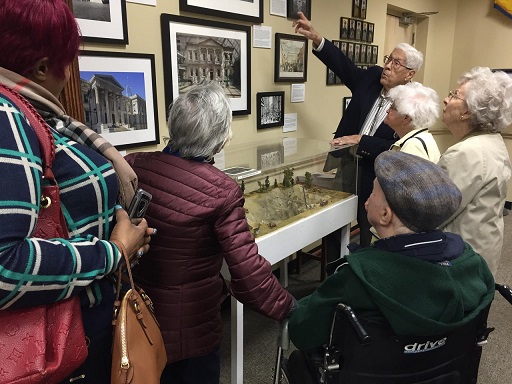
With the pandemic in full swing, and my dad’s health failing, our shared love of history sparked an idea. I started a social media page for Tuckahoe History on April 3 with a few photos. We enlisted the help of Nicholas Zanzano and Rob Farella, two other active members of the committee, who also had access to the archives and scanned photographs.
 My father and mother delighted in the responses each post on the Tuckahoe History page provoked! I couldn’t be with them as it was unsafe to travel, but I could cultivate the page and share that with my parents. And the audience grew from our family, to a few dozen additional friends, to more than 500 followers in a few short months.
My father and mother delighted in the responses each post on the Tuckahoe History page provoked! I couldn’t be with them as it was unsafe to travel, but I could cultivate the page and share that with my parents. And the audience grew from our family, to a few dozen additional friends, to more than 500 followers in a few short months.
My father often added details that enriched what others on the committee developed. Sometimes he’d have me post questions. “What roads in the village were named after presidents?” “What was a Charlotte Russe?” The audience we reached on social media brought viewers who contributed new photos, remembrances, and details that will now be part of the archived record. My dad got a kick out of the number of hits each post garnered. One post about the history of the Tuckahoe train station was seen by more than 3,500 people and shared on more than a dozen other pages.
I continue to manage the page in my parent’s honor. The post about my father’s death has been shared on 22 other pages and seen by more than 6,000 people. Dad would have been amazed and, to be truthful, a little embarrassed by the attention. The page honors Tuckahoe’s history and the elders’ recollections and contributions. We see how their grit got them through the tough times, and we are reminded how history has much to teach us.
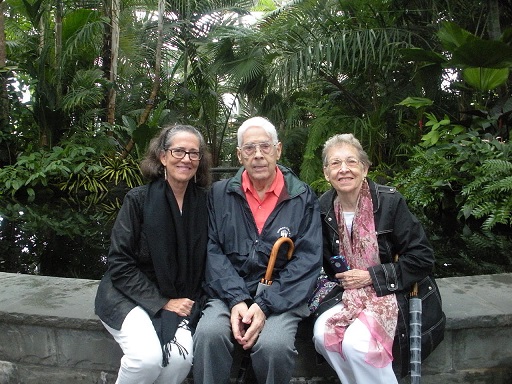
L’Idea Magazine: How much and how did your Italian roots influence you as a woman and a mother, and as a writer?
Marge Pellegrino: Family, cooking, gathering on Sundays for a shared meal to talk and laugh may sound stereotypical, but those elements are true to my experience. I also feel my Italian roots when I act in ways that remind my son he is loved. When he was growing up, we nudged him toward being a life-long learner, and let him know we expected him to work hard for his place in the world. I feel an Italian influence in my quest to find beauty in art, music, and the natural world; to be passionate and demonstrative about what matters, and to always consider sustainability. How can an object be fixed instead of replaced? How could I use what I already have? I do compost, even though our desert home relegates my garden to pots. These leanings grew from my family life, which was heavily influenced by my Italian roots.
While expressing my Italian heritage doesn’t drive my writing, it sometimes plays a starring role. Sometimes that influence informs my projects.
When I was growing up in the 1950s, my grandparents made a point of speaking only English in front of family. Their conversations flipped from Italian to English when a family member entered the room. Italian was a muffled music played softly in other rooms. As we would come to understand later, my grandparent’s English-only practice sprang from their belief that English would help their children and grandchildren be more American than my grandparents could ever be.
My Nana seldom talked about her impoverished childhood. Instead, her brother Gus was the one who had us spellbound with stories of their stepmother, who made Cinderella’s story seem plausible. The old witch even called the police on Nana and Gus when they were young, for stealing from the stash of food she kept locked up for the exclusive use of her own children.
Nana’s stories were from her adult life, wrapped in hope and shared while we cooked together. While I rolled meatballs between the palms of my hands, destined for the sauce she simmered on the stove after Sunday Mass, her stories showed me how her faith sustained her, especially after the death of her infant sons, and again after, when her little girl Angelina died a four-year-old with beautiful dark curls.
My Italian American backstory plays front-and-center for this award-winning poem published in SandScript Literary Journal in 2003. I wrote from a faded black and white photo. In it, Nana sitting in the living room on an upholstered chair, my little fair-haired brother standing at her side. Nana is holding me, her brand new granddaughter, with dark curly hair.
Locked outside the language
of my father’s culture
Nana’s stories
of a broken plaster statue who cried
and an evil stepmother who hid hoarded sweet cakes
in a wooden cabinet that opened like a steamer trunk
and a white dove that flew straight up into the sky
as the second infant Jimmy died
straight up from the roof of her house
delivering her baby’s soul to God’s arms
each mystery required to be shared in
a musicless cadence,
spoken only in the harsh consonants of
the language of my mother’s culture
except for the
Angelina
she whispered
in my ear as she rocked me,
Angelina
L’Idea Magazine: You studied and lived both in New York State and in Arizona. Could you tell us how the two different areas influenced you and your work as a writer?
Marge Pellegrino: The safe stable community I grew up in just outside New York City with tall trees is so different from Tucson, a sprawling city in a big-sky cactus-studded landscape near the border with Mexico. In both places, I took advantage of the community college system. Both Westchester and Pima Community Colleges welcomed my curiosity and were kind to my wallet. Both prepared me for advanced study and presenting in larger institutions, like Marist College in Poughkeepsie, New York, where I earned my Bachelor of Arts in Psychology and the University of Arizona where I took a few graduate-level courses and where I am grateful to have presented and collaborated with people in art, drama, and anthropology.
My work in both New York and Arizona taught me even more. What I learned from both work and education was supported by the foundation of community service, which my family laid.
At Consolidated Edison in Manhattan, I learned about service—not only customer service but also service delivered in kilowatts. I learned how to coach, how to facilitate workshops, how to encourage people to be kinder, and to be problem solvers. In Arizona, I used those communication skills with volunteers and families as well as in community and academic settings
When we moved to Arizona, one of our New York friends suggested that we were headed for a cultural abyss. We were pleasantly surprised that the arts and culture in Tucson proved to be very accessible. The experience of living in such different parts of the country offers diversity of thought and perspective. The NY community I grew up in was steeped in European mores and culture. In Tucson, I am surrounded by Latinx and Native American cultures. Through work, I’ve broken bread with families from Africa, Southeast Asia, and the Middle East.
I have now lived in Tucson longer than in New York and maintain friendships in both places. While Tucson affords me a more personal connection to the arts, academic, and border culture, my heart still calls New York home.
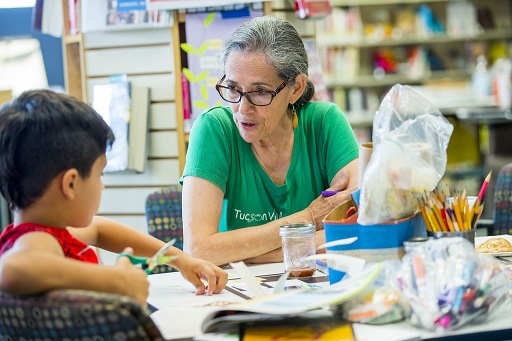
L’Idea Magazine: If you had the opportunity to meet and talk to any historical character, in any field you desire, who would it be? What would you like to talk about with them?
Marge Pellegrino: Knowing tomorrow’s answer would be different, today, I would invite composer Clara Schumann to tea to discuss how she developed her talent, her process, and how she succeeded in a field that took her down a seldom trod path for a woman.
L’Idea Magazine: In a situation as we have now with this pandemic, do you agree that writers can be more useful than ever? How?
Marge Pellegrino: Yes! Writers illuminate dark corners. They offer perspective, and so often inspire us to think, understand, and even sometimes, act. Especially now, I so appreciate writers who provide a respite for readers. And reading groups are another way to build community and foster thinking around a writer’s work.
L’Idea Magazine: A message for our readers?
Marge Pellegrino: I’m enthusiastic about writing’s ability to help people to grow, connect, and enrich themselves and others — so my message is no surprise: Try writing! This art form that’s accessible to most of us is also a powerful form of self-care. The time spent putting thoughts on paper provides a way to be present in the moment, express ourselves, think deeply, solve problems, and play; all important ways to cope with this challenging time and feed our own resilience. Writing can also allow us to communicate with a broader audience, or the most important audience of all, our friends and family.
To find out more about Marge, visit her website


